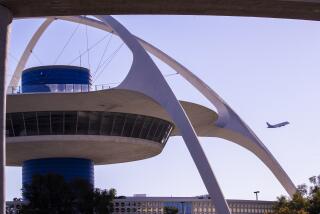Crash Inquiry Turns to Safety Alert
- Share via
WASHINGTON — The crash of a charter jet from Los Angeles last week in Aspen has revealed potential shortcomings in the Federal Aviation Administration’s handling of flight safety advisories.
At issue: possibly confusing wording and an apparent breakdown in the handling of an FAA advisory, called a “Notice to Airmen,” that concerned new restrictions on night landings at Aspen. The advisory, known as a NOTAM, went out two days before the Thursday crash. Couched in aviation jargon, the terse advisory included these words: “circling NA [not authorized] at night.”
Government officials and an independent private aviation safety expert caution, however, that there may ultimately be no cause-and-effect link between questions about the advisory and the accident, which killed all 18 people aboard. Air crash investigations cover many possibilities in painstaking detail, and initially intriguing leads may not pan out.
Nonetheless, the National Transportation Safety Board is investigating why the advisory apparently never reached tower controllers in Aspen.
“The FAA is conducting its own internal review to see whether changes are needed,” said FAA spokeswoman Laura Brown. “And we have revised the language in the Notice to Airmen” issued for Aspen.
The advisory was supposed to go out over FAA information networks that reach controllers at local airports, such as Aspen, as well as pilots around the country who may be drawing up their flight plans.
The pilot of the Gulfstream III jet did receive it, although questions have been raised about its clarity.
“The pilot was aware of the restriction,” said a second FAA official. “The overriding thing is that when a pilot comes in and says he has the runway in sight, he can land.”
Warren Morningstar, a spokesman for the Aircraft Owners and Pilots Assn., said his organization has been lobbying the FAA to modernize its system for distributing the advisories, which alert pilots to changes in procedures.
“It is not easy for a pilot to get all the NOTAMs that may affect the operations on their flight,” Morningstar said. “We would like to see all of them available on a server that is searchable.” Private and charter pilots are much more heavily dependent on NOTAMs than are airline pilots, who have extensive support systems.
According to an FAA official, the advisory was issued after an FAA pilot made an inspection of the Aspen airport. Located at an elevation of 7,820 feet and close to ridges, the airport is considered tricky for landings, especially at night and in poor weather.
The advisory went from the Aviation System Standards office in Oklahoma City to the FAA air traffic command center in Herndon, Va. From there, it was transmitted by computer to flight service stations that brief pilots around the country as well as to air traffic control centers that handle flights en route.
The Denver en route center was supposed to fax the advisory to controllers at the Aspen tower, said an FAA official.
“That is what we are looking at internally,” the official said. “We are wondering why they didn’t get it. That is our internal question mark.” There could be a problem with the FAA’s system for distributing the advisories, or the breakdown in communications may be the result of individual error.
The other branch of the FAA’s information network--flight service stations that brief pilots around the country--was working.
Questions have arisen about whether the use of the term “circling” could have confused the pilots.
There is a standard approach to Aspen that involves a circling descent in a racetrack oval pattern over the airport, said an FAA official. It may never be known whether this contributed to any confusion. The flight from Los Angeles was not using this circling descent pattern on the night of the accident.
The FAA has since changed the NOTAM to drop the term “circling” and specify that instrument approaches at night are not authorized. The pilot of the doomed plane was making an instrument approach, required in poor visibility, shortly after nightfall in falling snow.
However, an independent aviation safety expert said that the “circling” reference would have technically covered all instrument approaches into Aspen. That is because there is no straight-in instrument approach to the airport, and pilots must make quick right and left turns to line up properly with the runway, which can be construed as “circling.”
“It may have not immediately registered,” said the expert, who is also a private pilot. However, he said this situation should have been clear to the pilot on examination of his aviation charts for the airport. Moreover, pilot Bob Frisbie had flown into Aspen before. The expert asked not to be quoted by name because of the sensitivity of the investigation.
To further complicate matters, the definition of “night” may also be at issue in the crash. The plane struck a hillside at 7:01 p.m., about 30 minutes after sunset. But since airborne pilots can see sunlight longer than people on the ground, “night” for aviation purposes began at 6:58 p.m. The plane had been cleared to land before that.
Would it have made a difference if controllers at Aspen had received the FAA advisory? Would it have made a difference if the initial advisory had omitted the “circling” reference?
Several FAA officials and the private expert said they doubt it would have changed the outcome. “This points up shortcomings in the NOTAM system, but I suspect it is not going to be a factor in the accident,” said the expert.
FAA officials said controllers at Aspen would have warned the pilot but probably would have allowed him to land anyway, since he had said he could see the runway.
The NTSB is investigating these circumstances, but it may take months before it reaches a conclusion.
More to Read
Inside the business of entertainment
The Wide Shot brings you news, analysis and insights on everything from streaming wars to production — and what it all means for the future.
You may occasionally receive promotional content from the Los Angeles Times.










